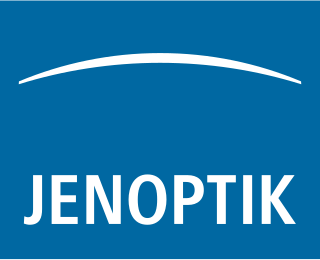
Photonics is a branch of optics that involves the application of generation, detection, and manipulation of light in form of photons through emission, transmission, modulation, signal processing, switching, amplification, and sensing. Photonics is closely related to quantum electronics, where quantum electronics deals with the theoretical part of it while photonics deal with its engineering applications. Though covering all light's technical applications over the whole spectrum, most photonic applications are in the range of visible and near-infrared light. The term photonics developed as an outgrowth of the first practical semiconductor light emitters invented in the early 1960s and optical fibers developed in the 1970s.

Elbit Systems Ltd. is an Israel-based international military technology company and defense contractor. Founded in 1966 by Elron, Elbit Systems is the primary provider of the Israeli military's land-based equipment and unmanned aerial vehicles.

Selex ES was a subsidiary of Finmeccanica S.p.A., active in the electronics and information technology business, based in Italy and the UK, and formed in January 2013, following Finmeccanica's decision to combine its existing SELEX Elsag and SELEX Sistemi Integrati businesses into SELEX Galileo, the immediate predecessor of Selex ES. From 1 January 2016, the activities of Selex ES merged into Leonardo-Finmeccanica's Electronics, Defence and Security Systems Sector becoming Leonardo S.p.A.

PerkinElmer, Inc., previously styled Perkin-Elmer, is an American global corporation that was founded in 1937 and originally focused on precision optics. Over the years it went into and out of several different businesses via acquisitions and divestitures; these included defense products, semiconductors, computer systems, and others. By the 21st century, PerkinElmer was focused in the business areas of diagnostics, life science research, food, environmental and industrial testing. Its capabilities include detection, imaging, informatics, and service. It produced analytical instruments, genetic testing and diagnostic tools, medical imaging components, software, instruments, and consumables for multiple end markets. PerkinElmer was part of the S&P 500 Index and operated in 190 countries.
SPIE is an international not-for-profit professional society for optics and photonics technology, founded in 1955. It organizes technical conferences, trade exhibitions, and continuing education programs for researchers and developers in the light-based fields of physics, including: optics, photonics, and imaging engineering. The society publishes peer-reviewed scientific journals, conference proceedings, monographs, tutorial texts, field guides, and reference volumes in print and online. SPIE is especially well-known for Photonics West, one of the laser and photonics industry's largest combined conferences and tradeshows which is held annually in San Francisco. SPIE also participates as partners in leading educational initiatives, and in 2020, for example, provided more than $5.8 million in support of optics education and outreach programs around the world.

An optical fiber, or optical fibre, is a flexible glass or plastic fiber that can transmit light from one end to the other. Such fibers find wide usage in fiber-optic communications, where they permit transmission over longer distances and at higher bandwidths than electrical cables. Fibers are used instead of metal wires because signals travel along them with less loss and are immune to electromagnetic interference. Fibers are also used for illumination and imaging, and are often wrapped in bundles so they may be used to carry light into, or images out of confined spaces, as in the case of a fiberscope. Specially designed fibers are also used for a variety of other applications, such as fiber optic sensors and fiber lasers.

Jenoptik AG is a Jena, Germany-based integrated photonics company. The company is listed on the Frankfurt Stock Exchange and is included in the TecDAX stock index.
Luna Innovations is an American developer and manufacturer of fiber-optics- and terahertz-based technology products for the aerospace, automotive, communications, defense, energy, infrastructure, security, and silicon photonics industries. It is headquartered in Roanoke, Virginia. Luna's products are used to test, measure, analyze, monitor, protect and improve products and processes to enhance the safety, security, and connectivity of people.
A photonic integrated circuit (PIC) or integrated optical circuit is a microchip containing two or more photonic components that form a functioning circuit. This technology detects, generates, transports, and processes light. Photonic integrated circuits utilize photons as opposed to electrons that are utilized by electronic integrated circuits. The major difference between the two is that a photonic integrated circuit provides functions for information signals imposed on optical wavelengths typically in the visible spectrum or near infrared (850–1650 nm).
Ophir Optronics Solutions is a multinational company that sells optronics solutions. The company develops, manufactures and markets infrared (IR) optics and laser measurement equipment. Founded in 1976, the company was traded on the Tel Aviv Stock Exchange from 1991 until it was acquired, and was a constituent of its Tel-tech index. Headquartered in the Har Hotzvim industrial park in Jerusalem, Israel Ophir owns a 100,000-square-foot (9,300 m2) complex that includes the group's main production plant. Ophir has additional production plants in North Andover, Massachusetts and Logan, Utah in the US and sales offices in the US, Japan and Europe. In 2006, Ophir acquired Spiricon Group, a US-based company in the beam-profiling market. Ophir's sales increased sharply from $45 million in 2005 to $74 million in 2007. During 2007, Ophir established a Swiss-based subsidiary to market lenses and components for surveillance and imaging systems in Europe. In May 2010, Ophir acquired Photon Inc., another US-based beam-profiling company. Newport Corporation, a global supplier in photonics solutions, completed its acquisition of the Ophir company in October 2011. In 2016, metrology firm MKS Instruments bought Newport Corporation, including the Ophir brand, for $980 million.
The National Optics Institute (INO) is a Quebec City-based private non-profit corporation founded in 1988. INO is a technological design and development firm that deals in optics and photonics for SMEs and large corporations in Canada and around the world. INO has 147 patents granted. In addition, over 103 other patent applications have been submitted and are awaiting approval. INO was recognized as a Centre of Excellence and Innovation by the Canadian government.
The European Photonics Industry Consortium (EPIC) is a not-for-profit association with headquarters in Paris, France. EPIC serves the photonics community through a regular series of workshops, market studies and partnering. EPIC focuses its actions on LEDs and OLEDs for lighting, optical fiber telecommunications, laser manufacturing, sensors, photovoltaics and photonics for life sciences. EPIC coordinates its activities internationally through its membership in the International Optoelectronics Association.

Robert Louis Byer is a physicist. He was president of the Optical Society of America in 1994 and of the American Physical Society in 2012.

Prior Scientific Instruments Ltd was established in London in 1919 as a manufacturer of optical microscopes. It is the last traditional microscope manufacturer of makers such as Vickers, W.Watson and Son, Baker, Charles Perry, Cooke, Troughton & Simms and many others who have ceased to produce microscopes.

Kenneth O. Hill is a Mexican Canadian physicist who specializes in the field of photonics. In the late 1970s, he discovered the phenomena of photosensitivity in optical fiber and has worked extensively in its applications. He first demonstrated Fiber Bragg gratings and their applications in optical communication and optical sensor systems. Further areas of his discovery and innovation include the phase mask technique for grating fabrication, fiber grating dispersion compensators, and wavelength selective fiber filters, multiplexers and demultiplexers. This field of research has led to the ability to create high speed fiber optic networks as well as many other communication applications that have revolutionized the telecommunications industry.
Taylor Hobson is an English company founded in 1886 and located in Leicester, England. Originally a manufacturer of still camera and cine lenses, the company now manufactures precision metrology instruments—in particular, profilometers for the analysis of surface textures and forms.
AMETEK, Inc. is an American multinational conglomerate and global designer and manufacturer of electronic instruments and electromechanical devices with headquarters in the United States and over 220 sites worldwide.

Paul F. McManamon is an American scientist who is best known for his work in optics and photonics, as well as sensors, countermeasures, and directed energy.

Satrec Initiative or SI is a South Korean satellite manufacturing company headquartered in Daejeon, South Korea The company was founded in 1999 by the engineers who developed the first Korean satellite (KITSAT-1) at KAIST SaTRec. The company designs and builds Earth observation satellites called SpaceEye-series, and it provides various space components, including high resolution electro-optical payloads and star-trackers. SI's first satellite was a Malaysian Earth observation satellite, RazakSAT launched in 2009. SI has two subsidiaries: SI Imaging Services (SIIS) is the exclusive image data provider of KOMPSAT-series, and SI Analytics (SIA) provides AI-native GEOINT solutions for satellite imagery. SI also spun-off SI Detection (SID), which provides radiation monitoring solutions.

Shlomi Arnon, is a professor in the Department of Electrical and Computer Engineering at Ben Gurion University of the Negev (BGU), Israel. In addition to his role as a professor, he serves as the director of both the Center for Quantum Science and Technology (BGU-QST) and the Satellite and Wireless Communication Laboratory at the university. For his contributions to the field of optics and photonics, he has been recognized as a fellow of the International Society for Optics and Photonics (SPIE).











